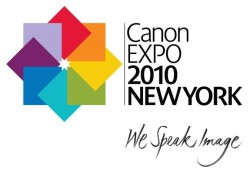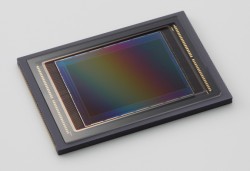 Anyone who uses Canon equipment in their home, office, studio, or printing business would have been fascinated by the Canon EXPO 2010 New York held earlier this month at the Jacob Javits Center. Unlike a trade show in which the focus is on getting leads and selling products, the invitation-only Canon EXPO was more like a giant science fair that allowed visitors to get a real sense of what the Canon brand represents and how some of Canon’s core technologies are used in multiple products, markets, and applications.
Anyone who uses Canon equipment in their home, office, studio, or printing business would have been fascinated by the Canon EXPO 2010 New York held earlier this month at the Jacob Javits Center. Unlike a trade show in which the focus is on getting leads and selling products, the invitation-only Canon EXPO was more like a giant science fair that allowed visitors to get a real sense of what the Canon brand represents and how some of Canon’s core technologies are used in multiple products, markets, and applications.
The museum-like exhibits were staffed by proud Canon employees who showcased some of the results from Canon’s extensive investments in R&D. Many of the exhibits included prototypes of possible future products upon which creative entrepreneurs could start developing new businesses.
The 150,000 sq. ft. of the EXPO space was divided into 11 exhibit zones. Each zone reinforced the Canon theme: “We Speak Image.” Most zones depicted how current, new, and potential imaging products might be used by consumers, medical personnel, film and television producers, photographers, reprographers, security personnel, commercial printers, professional photographers. Visitors could also see all the different ways Canon products might be used by employees in different the different departments of a typical corporation (e.g., employee training, human resources, accounting, legal, marketing, manufacturing, etc.) Two zones highlighted Canon’s activities related to the environment and community and custom support. Visitors were encouraged linger, ask questions, test equipment for themselves, and suggest ideas for improvement or possible applications.
The Future of Imaging
Three future-focused zones of Canon EXPO demonstrated that now that digital printing and imaging has totally transformed traditional photography and printing processes, we are on the brink of discovering bold new ways to use images that were never before possible.
For example, Canon showed elements of their Mixed-Reality Initiative, including head-mounted displays with built-in cameras and a computer that processes video to blend the real and virtual world. The result is a visual experience in which users can not only “see” images in a visual space, but also control and create them. Mixed-Reality technology is expected to be used in fields such as design simulations and prototype-less development, medical diagnosis and surgery assistance, education, exhibitions, and entertainment.
 Canon also showcased what it believes is the world’s largest CMOS image sensor, with a chip size measuring 202 x 205 mm. Because its expanded size enables greater light-gathering capability, the sensor can capture images in approximately one one-hundredth the amount of light required by a Canon pro-model digital SLR camera. Possible applications include shooting video of the stars and nocturnal animals or night-time surveillance.
Canon also showcased what it believes is the world’s largest CMOS image sensor, with a chip size measuring 202 x 205 mm. Because its expanded size enables greater light-gathering capability, the sensor can capture images in approximately one one-hundredth the amount of light required by a Canon pro-model digital SLR camera. Possible applications include shooting video of the stars and nocturnal animals or night-time surveillance.
A second CMOS image sensor, which is APS-H-size2 delivers an image resolution of approximately 120 megapixels (13,280 x 9,184 pixels), which Canon believes is the world’s highest level of resolution for its size.
To demonstrate the level of detail these futuristic sensors could capture, one wall featured a huge panoramic print that combined a still images with embedded video elements. On an adjacent wall, a small portion of the huge panoramic print had been cropped out, enlarged, and printed at about 5 x 8 ft.
Also on display were Canon’s proposed new lightweight and compact, Multipurpose Camera that supports both video and still image capture with ultra-high definition 4K resolution. Canon’s future Cross Media Station (CMST) will enable video and still imagery shot with Canon devices to be played back and enjoyed by the whole family utilizing an HDMI cable connection to the television.
To allow viewers to fully experience the high-definition content being captured by Canon devices, Canon showcased three new high-resolution liquid crystal panel display units, featuring 8K, 4K and 2K high-resolution liquid crystal panels and high image-quality display engines. These new types of monitors will display high-definition medical images and images being processed by commercial printers, video producers, and professional photographers.
The Future of Printing
In one of the Canon Expo seminars, printing-industry analyst Frank Romano talked about how much print work is being transferred from conventional processes to digital printing. In 2000, the percentage of print jobs done digitally was just 24%. This has risen to 43% in 2010 and is expected to reach 58% by 2020. However, the overall volume of print jobs has been shrinking as print runs have become shorter and more and more information is published online or delivered electronically in the form of PDF documents.
According to Romano, commercial printers can no longer afford to specialize in one or two categories of printing, but must recognize that everyone in the graphics and printing business is competing with everyone else. He contends that the future of printing will involve printing things that aren’t now being printed. He also suggested that no one in the printing business can afford to feel complacent with their current mix of services, and should continually strive to look for new services that are difficult for customers to do on their own.
Some of the commercial presses and large-format printing equipment that Canon has developed to handle shifts in the demand for printing were displayed in a zone entitled “The Power of Synergy.” This zone emphasized the benefits of the partnership between Canon and Océ, and featured the types of Canon and Océ equipment that might be used in four different types of environments: a commercial printing company, an in-plant print facility, a reprographic/sign shop, or architecture and design office.
Some of the devices on display included the Océ Arizona 550 XT Large-Format UV Flatbed Printer, the Océ ProCut 2500 L large-format cutting solution, the imagePRESS C7010VP electrographic digital color press, and the Océ JetStream full-color high-speed inkjet for ultra-high-volume , full-color production printing.
One of the concept prototype devices on display in The Power of Synergy Zone is a six-color, 60-in. imagePROGRAF® X wide-format printer that will use new environmentally friendly, odor-free, water-based inks to produce high-quality images on a wide range of materials for both indoor and outdoor signage. One key technology being developed for this concept printer is a new drying process for complete in-machine drying.
For photo printing, Canon was highlighting a new generation of PIXMA printers that will enable consumers to print individual frames of HD movies captured on compatible HD Canon ESO and PowerShot digital cameras. This capability means consumers will be less likely to miss capturing that memorable moment when a child blows out the candle on the birthday cake or the bride gives her father that special look when they dance during the wedding.
Other zones in the Expo showed Canon printers being used to print medical images captured with Canon’s digital radiography machines and to print posters, proofs, catalogs, books, and documents in different departments of the imaginary “Advanced Image Apparel” corporation.
Most visitors to the Canon EXPO probably went to the show primarily to learn more about those technologies that directly impact their current operations. But many undoubtedly walked away with a much broader view of Canon’s product line as a whole, as well as hints of emerging technologies that could potentially expand (or alter) their current businesses.
In their welcome message to EXPO attendees, Fujio Mitarai, chairman and CEO of Canon, and Joe Adachi, president and CEO of Canon USA noted that. “We understand what images are capable of, and how to capture and deliver them with the highest quality. We know the power of images and how they can communicate creativity and knowledge. And we know where imaging is headed—as we continue to develop new ways to express ideas and information.”
Future posts on this blog will examine some of Canon’s technologies for imaging and printing in more detail.
